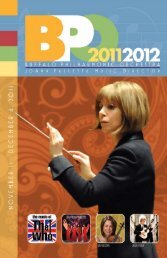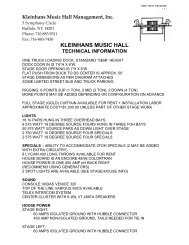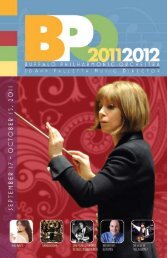Untitled - The Buffalo Philharmonic Orchestra
Untitled - The Buffalo Philharmonic Orchestra
Untitled - The Buffalo Philharmonic Orchestra
You also want an ePaper? Increase the reach of your titles
YUMPU automatically turns print PDFs into web optimized ePapers that Google loves.
2010-2011 75th Anniversary Celebration!<br />
than a playboy, a libertine with a simple<br />
goal - to seduce every woman in sight.<br />
Other versions place him in a role mostly<br />
foolish, more like a silly romancer than a<br />
crafty paramour, as in the case of the Don<br />
Juan by by Nikolaus Lenau (1802-1850),<br />
the Austrian poet whose work provided<br />
the character model for Strauss.<br />
In fact, the Lenau variation is a tale of<br />
Don Juan’s relentless search for the perfect<br />
woman - one who is at once spiritually and<br />
sensually ideal. But the frenzy of the quest<br />
obscures and eclipses the dream. After a<br />
lifetime of manic pursuit the Don becomes<br />
disillusioned, dispassionate and tired of<br />
the world, its women - and ultimately -<br />
himself. Near the close he welcomes<br />
the challenge of a duel with Don Pedro<br />
who swears to redeem the honor of his<br />
sister, who of course had fallen to the<br />
wiles of our amorous conquistador. In<br />
self-retribution, Don Juan allows himself to<br />
be killed.<br />
Strauss’ music, though youthfully<br />
conceived, reveals a composer already<br />
at home in his métier of grandiloquent<br />
orchestration. <strong>The</strong> motifs - macho and<br />
brash and tender all at once - are<br />
splendidly cast over harmonies which<br />
convey the quixotic, double pursuit of<br />
soul and sensuality. Without following<br />
a literal course, Strauss tone-paints a<br />
series of episodes in the life of Don Juan<br />
by representing the spirit of the chase in<br />
florid tonalities. Indeed, the work is a<br />
symphonic tour de force, in turns brazen<br />
or tender, replete with noble melodies<br />
and emotive harmonies.<br />
<strong>The</strong> score also contains some of the<br />
dreamiest moments in music via enamored<br />
solos in the violin and oboe. Stand by as<br />
well for the principal theme heard several<br />
times strutting through the lusty choir<br />
of horns. But just as we might sense a<br />
developing apotheosis, the skies darken<br />
with ominous tones - the knell and toll of<br />
the avenging stroke of Don Pedro. Alas,<br />
the curtain closes on the sad career of<br />
Don Juan.<br />
Vier letzte Lieder - Four Last Songs<br />
Frühling Spring<br />
September September<br />
Beim Schlafengehen Going to Sleep<br />
Im Abendrot At Sunset<br />
First Classics performance: December 1,<br />
1942, with soprano Lotte Lehmann,<br />
conducted by Franco Autori; most recent<br />
performance: September 21, 2002, with<br />
soprano Renee Fleming, conducted by<br />
JoAnn Falletta; duration 25 minutes<br />
German Lieder (art songs) comprised<br />
a genre unto its own until roughly the<br />
beginning of the Romantic era. It was<br />
about that time when the venerable form<br />
began to respond to influences from the less<br />
structured but intimate ballads from England<br />
and the Continent at large. However, as<br />
the Lied became more flexible, the genre<br />
was once again dominated by exquisite<br />
examples from great Viennese and<br />
German masters such as Franz Schubert,<br />
Robert Schumann, Hugo Wolf, Gustav<br />
Mahler and, of course, Richard Strauss.<br />
It is often noted that the latter’s true<br />
calling was revealed through his scores<br />
for the human voice. Strauss’ output is<br />
ravishing: among sixteen operas are<br />
Der Rosenkavalier, Salomé, Elektra and<br />
Ariadne auf Naxos and a body of over<br />
200 published songs for a variety of<br />
voices, several of which were orchestrated<br />
by the composer himself. However, almost<br />
all of his songs were scored prior to 1900.<br />
Except for about twelve Lieder written after<br />
World War I, Strauss did not seriously<br />
return to the form until the last months of his<br />
life. <strong>The</strong> Four Last Songs were completed<br />
just days before the composer’s death. <strong>The</strong><br />
poetry Strauss selected for the settings is<br />
often considered as a memoir of his life<br />
and career.<br />
But even as Strauss was an octegenarian<br />
when he conceived the Four Last Songs,<br />
we are charmed by the poignant allure of<br />
the works. Completed in 1949, just days<br />
before the composer’s death, the song<br />
cycle is revered as an exquisite adieu to<br />
19






